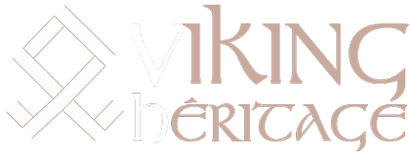🚚 Free shipping on orders over $60 + 10% off with code VIKING10
🚚 Free shipping on orders over $60 + 10% off with code VIKING10
¿Quién es Morrígan? La diosa irlandesa
septiembre 05, 2024 4 lectura mínima

¿Quién es Morrígan? La diosa irlandesa y sus paralelismos con la mitología vikinga
Morrígan, o "An Morrígan", es una figura icónica de la mitología celta irlandesa , a menudo representada como diosa de la guerra y la muerte . Sin embargo, la realidad es mucho más matizada. También se la asocia con la fertilidad, la soberanía y el destino. Morrígan comparte rasgos comunes con ciertas deidades vikingas . Exploremos esta compleja diosa y los paralelismos entre las culturas celta y nórdica.
El misterio detrás de su nombre
El nombre “ Morrigan ” tiene varias interpretaciones posibles. Se la conoce como la “ Reina Fantasma ”, nombre que deriva de las raíces de pesadilla y realeza. Sin embargo, otra explicación sugiere que podría ser la “Gran Reina ”, figura de poder y majestuosidad, visión reflejada en los relatos donde encarna la soberanía y la prosperidad .
Esta multiplicidad de roles recuerda a diosas de la mitología vikinga como Freyja , que, como Morrígan, está asociada tanto con la fertilidad como con la guerra, o Hel , la diosa de los muertos. Al igual que Morrígan, estas figuras femeninas nórdicas son temidas y reverenciadas, y gobiernan aspectos contrastantes de la vida y la muerte .
La Gran Reina y su divina compañera
Al igual que en la mitología nórdica , la mitología celta presenta poderosas parejas divinas . Morrígan suele asociarse con An Dagda, un dios todopoderoso, comparable a Odín en la tradición nórdica. Su unión asegura la victoria de los Tuatha Dé Danann sobre sus enemigos, de forma muy similar a como Odín y Freyja trabajan juntos para influir en el destino de los mortales y los dioses . Esta pareja divina también refleja a los dioses creadores vikingos, como Odín y Frigg, cuya unión es fundamental para mantener el equilibrio del cosmos.
Morrígan, diosa de la guerra... pero no sólo eso
Aunque Morrígan suele ser considerada diosa de la guerra , su papel va mucho más allá. En la mitología celta, también está relacionada con la fertilidad y la abundancia , al igual que Freyja en la mitología nórdica. Lejos de ser una figura puramente destructiva, simboliza el ciclo de la vida , donde la muerte y el renacimiento están intrínsecamente vinculados.
Morrígan y sus múltiples caras: la triple diosa
Al igual que ciertas figuras de la mitología vikinga, Morrígan es percibida como una diosa triple, representada por tres aspectos: Morrígan, Macha y Badb . Este tríptico divino refleja la complejidad de sus atributos y su capacidad para influir en el destino de reyes y héroes, de manera similar a las Nornas nórdicas, que tejen los hilos del destino humano. Los vikingos creían firmemente en este concepto de destino inmutable, al igual que los celtas veían a Morrígan como una figura capaz de dar forma al futuro .
Morrígan y los vikingos: ¿creencias compartidas?
Es interesante destacar que, aunque los celtas y los vikingos se desarrollaron en entornos culturales distintos, compartían creencias similares . La reverencia por las fuerzas naturales, la importancia de la soberanía y la conexión con la muerte y la guerra son temas centrales en ambas mitologías. Morrígan, con sus cuervos volando sobre los campos de batalla, se hace eco de Odín, a menudo representado con sus cuervos Huginn y Muninn, que simbolizan el pensamiento y la memoria. Estas aves acompañan a las deidades en el campo de batalla y actúan como mensajeros del destino.
Morrígan y Cú Chulainn: una relación de amor-odio, similar a la de los héroes vikingos

Una de las historias más famosas de la mitología irlandesa es la compleja relación entre Morrígan y el héroe Cú Chulainn . Al igual que los héroes vikingos como Ragnar Lodbrok o Sigurd , Cú Chulainn se enfrenta a decisiones que sellan su destino. Morrígan intenta atrapar a Cú Chulainn, al igual que los dioses nórdicos suelen poner a prueba a los héroes. Su relación con él refleja la de los dioses nórdicos y sus campeones mortales, donde el honor, la guerra y el destino están estrechamente entrelazados.
Conclusión: un puente entre dos mundos mitológicos
Morrígan es mucho más que una diosa de la guerra . A través de sus múltiples roles y encarnaciones, encarna la fertilidad, la soberanía, la prosperidad y la muerte , temas recurrentes tanto en la mitología celta como en la nórdica. Los vikingos, al igual que los celtas, veneraban a complejas figuras divinas que influían en todos los aspectos de la vida. Lejos de ser meras figuras de destrucción, estas diosas también eran símbolos de renovación y poder.
Situando a Morrígan en un contexto más amplio, vemos que las creencias celtas y vikingas no están tan alejadas . Sus deidades, aunque adaptadas a sus respectivas culturas, comparten funciones y temas comunes, lo que refuerza la importancia de la espiritualidad en las sociedades antiguas.
Dejar un comentario
Los comentarios se aprobarán antes de mostrarse.




